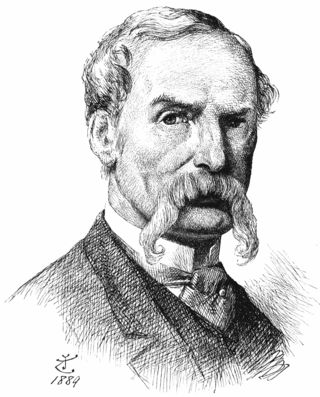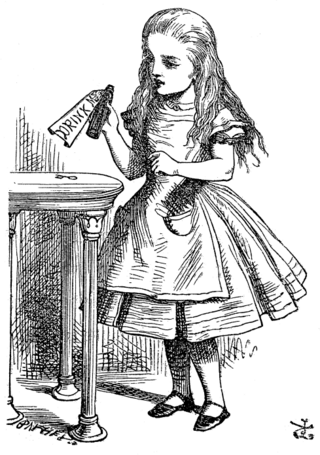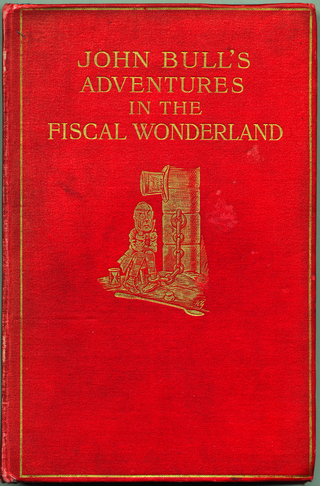
Sir John Tenniel was an English illustrator, graphic humourist and political cartoonist prominent in the second half of the 19th century. An alumnus of the Royal Academy of Arts in London, he was knighted for artistic achievements in 1893, the first such honour ever bestowed on an illustrator or cartoonist.

Through the Looking-Glass, and What Alice Found There is a novel published on 27 December 1871 by Lewis Carroll, a mathematics professor at the University of Oxford, and the sequel to Alice's Adventures in Wonderland (1865). Alice again enters a fantastical world, this time by climbing through a mirror into the world that she can see beyond it. There she finds that, just like a reflection, everything is reversed, including logic.
The Annotated Alice is a 1960 book by Martin Gardner incorporating the text of Lewis Carroll's major tales, Alice's Adventures in Wonderland (1865) and Through the Looking-Glass (1871), as well as the original illustrations by John Tenniel. It has extensive annotations explaining the contemporary references, mathematical concepts, word play, and Victorian traditions featured in the two books.

Alice's Adventures in Wonderland is an 1865 English children's novel by Lewis Carroll, a mathematics don at Oxford University. It details the story of a young girl named Alice who falls through a rabbit hole into a fantasy world of anthropomorphic creatures. It is seen as an example of the literary nonsense genre. The artist John Tenniel provided 42 wood-engraved illustrations for the book.

Alice is a fictional character and the main protagonist of Lewis Carroll's children's novel Alice's Adventures in Wonderland (1865) and its sequel, Through the Looking-Glass (1871). A child in the mid-Victorian era, Alice unintentionally goes on an underground adventure after falling down a rabbit hole into Wonderland; in the sequel, she steps through a mirror into an alternative world.

Alice Pleasance Hargreaves was an English woman who, in her childhood, was an acquaintance and photography subject of Lewis Carroll. One of the stories he told her during a boating trip became the children's classic 1865 novel Alice's Adventures in Wonderland. She shared her name with "Alice", the story's heroine, but scholars disagree about the extent to which the character was based upon her.

Lewis Carroll's books Alice's Adventures in Wonderland (1865) and Through the Looking-Glass (1871) have been highly popular in their original forms, and have served as the basis for many subsequent works since they were published. They have been adapted directly into other media, their characters and situations have been appropriated into other works, and these elements have been referenced innumerable times as familiar elements of shared culture. Simple references to the two books are too numerous to list; this list of works based on Alice in Wonderland focuses on works based specifically and substantially on Carroll's two books about the character of Alice.

The Looking Glass Wars is a series of three novels by Frank Beddor, heavily inspired by Lewis Carroll's 1865 novel Alice's Adventures in Wonderland and its 1871 sequel Through the Looking-Glass. The premise is that the two books written by Lewis Carroll are a distortion of the "true story".

Edward Harold Begbie, also known as Harold Begbie, was an English journalist and the author of nearly 50 books and poems. Besides studies of the Christian religion, he wrote numerous other books, including political satire, comedy, fiction, science fiction, plays and poetry. He died in London on 8 October 1929.
Betty in Blunderland is a Fleischer Studios animated short film starring Betty Boop, which was released on the 6th of April in 1934. Also known as Betty in Flunkerland.

Lost in Blunderland: The Further Adventures of Clara is a novel by Caroline Lewis, written in 1903 and published by William Heinemann of London. It is a political parody of Lewis Carroll's two books, Alice's Adventures in Wonderland (1865) and Through the Looking-Glass (1871) and the sequel to Lewis' Clara in Blunderland. Lost in Blunderland, like its precursor, criticises the British government's approach to the Second Boer War.
Lewis Carroll’s 1865 novel Alice's Adventures in Wonderland has been translated into 175 languages. The language with the most editions of the Alice in Wonderland novels in translation is Japanese, with 1,271 editions. Some translations, with the first date of publishing and of reprints or re-editions by other publishers, are:

John Bull's Adventures in the Fiscal Wonderland is a novel by Charles Geake and Francis Carruthers Gould, written in 1904 and published by Methuen & Co. of London. It is a political parody of Lewis Carroll's two books, Alice's Adventures in Wonderland (1865) and Through the Looking-Glass (1871).

Alice in Blunderland: An Iridescent Dream is a novel by John Kendrick Bangs. It was first published in 1907 by Doubleday, Page & Co. of New York, with illustrations by Albert Levering. It is a political parody of the two Alice books by Lewis Carroll, Alice's Adventures in Wonderland (1865) and Through the Looking-Glass (1871).

The Westminster Alice is the name of a collection of vignettes written by Hector Hugh Munro (Saki) in 1902 and published by The Westminster Gazette of London. It is a political parody of Lewis Carroll's two books, Alice's Adventures in Wonderland (1865) and Through the Looking-Glass (1871).

Rollo in Emblemland or Emblemland is a novel by John Kendrick Bangs, written in 1902 and published by R. H. Russell of New York. It is a tale inspired by the style of Lewis Carroll's 1865 book, Alice's Adventures in Wonderland.

Davy and the Goblin, or, What Followed Reading "Alice's Adventures in Wonderland" is a novel by Charles E. Carryl that was serialized in St. Nicholas magazine from December 1884 to March 1885 before being published by Houghton Mifflin of Boston and Frederick Warne of London in 1885. It was one of the first "imitations" inspired by Lewis Carroll's two books, Alice's Adventures in Wonderland (1865) and Through the Looking-Glass (1871).

Illustrators of the Alice books, Alice's Adventures in Wonderland (1865) and Through the Looking-Glass (1871), number more than 100. The focus here is on English-language editions. Many other artists have created illustrations for non-English language editions. The illustrator for the original editions was John Tenniel, whose illustrations for Alice and Looking Glass are perhaps the best known illustrations ever published. This article is an ongoing attempt to list all major illustrators of the Alice books from 1899 to the present day.

Alice in Wonderland, or simply Alice, is a Disney media franchise, commencing in 1951 with the theatrical release of the animated film Alice in Wonderland. The film is an adaptation of the books by Lewis Carroll, the 1865 novel Alice's Adventures in Wonderland and its 1871 sequel Through the Looking-Glass, which featured his character Alice. A live-action film directed by Tim Burton was released in 2010.
Michael Henry Temple (1862–1928) was an English journalist and author. He is now known as the inventor of the chess variant Kriegspiel.
















